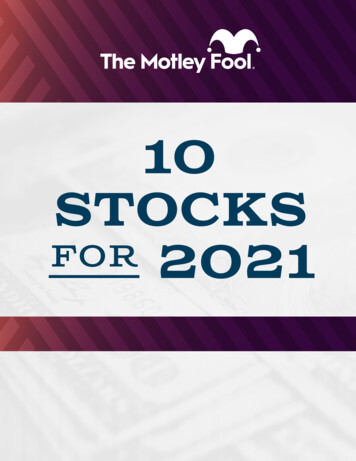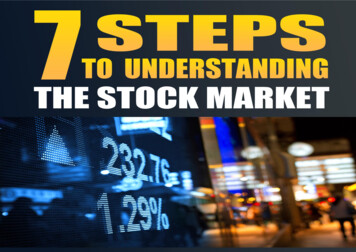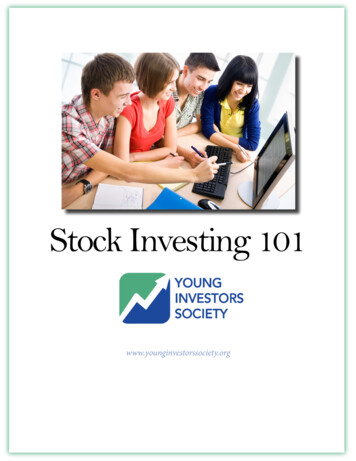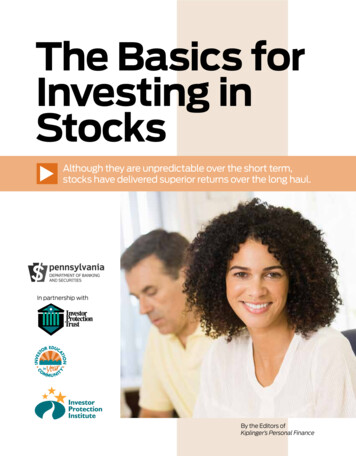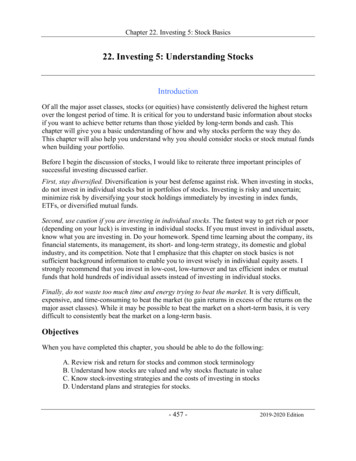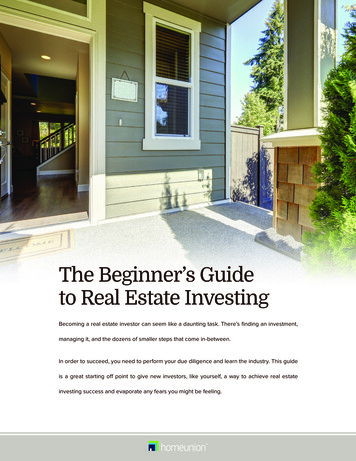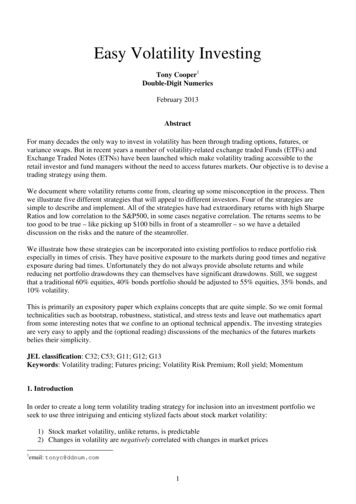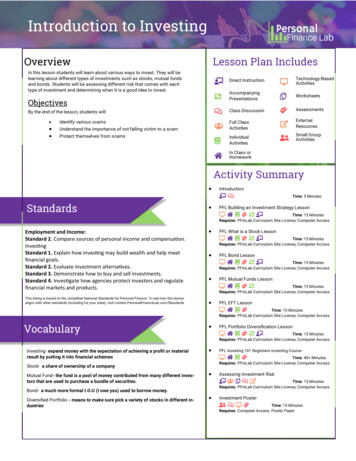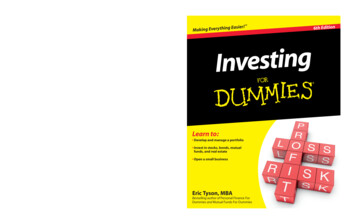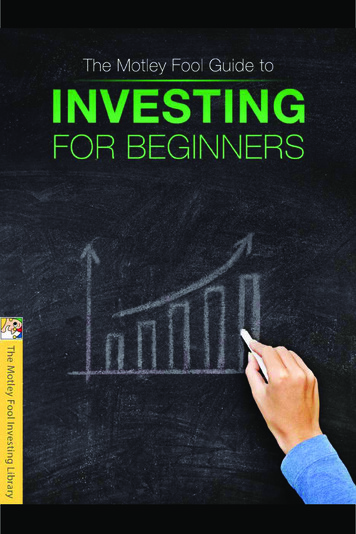
Transcription
The Motley Fool Guide to.Investing forBeginnersby The Motley FoolAcknowledgementsSpecial thanks to David Gardner, Tom Gardner, Keith Pelczarski,Robert Sheard, Michael Knight, Randy Befumo, Bill Barker,Dayana Yochim, Brian Bauer, Joe Magyer, Robert Brokamp,Denise Coursey, Robyn Gearey, Roger Friedman, Dari FitzGerald,Sara Hov, Ilan Moscovitz, Jeff Fischer, Ron Gross, Jason Moser,Alyce Lomax, Jim Mueller, Adam Wiederman, Iain Butler, MorganHousel, and all the other Fools who contributed to this project.Copyright 2015, The Motley Fool
The Motley Fool Guide to Investing for BeginnersIntro:Your Ticket to FinancialIndependenceWhy do you want to invest?Some people have dreams of an early retirement. Others want to besure they can afford to send their children to their college of choice.And many more want to be able to leave a legacy for their families.A few just want to buy a really sweet boat.Whatever your reasons — and there’s no bad reason to invest —it’s really all about creating opportunity. You want to earn enoughthrough your investments to ensure your financial comfort and tobe able do the things that matter most to you.You may not realize it, but you’re about to embark on a journey tofinancial independence. In the same way modest initial investmentscan amount to life-changing sums down the road, these few modestpages might well make a huge difference in your life, enabling youto retire in your 50s, send your grandchildren to college, buy thatsummer place on Lake Whatchamacallit, or fly around the world ina zeppelin.If you’re an investor — or a soon-to-be investor — you’ve probablyheard of The Motley Fool. But you might not yet have a good graspof what we’re all about and what it could mean for you.The Motley Fool was conceived by David Gardner, Tom Gardner,and Erik Rydholm, who created the first issue of The Motley Foolprinted newsletter in July 1993. The Fool debuted online a yearlater, with the same goal we have today: To help you to invest fori
The Motley Foolyourself and gain control of your personal finances.We were founded as an antidote to the conventional wisdom thatthe individual investor was doomed to underperformance. In fact,we’ve proven empirically and unquestionably that individuals canbeat Wall Street.Our mission is to help the world invest — better.The Motley Fool truly is a place with a passion and a purpose.Our workplace has won awards and been highlighted as one ofAmerica’s greatest places to work, and we settle debates at thefoosball table. There is a lot of laughter within the walls of FoolHQ. But we are serious about the business of financial educationand advice — after all, your money is on the line, and so is ours.Our name comes from Shakespeare, whose fools instructed andamused, and could speak the truth to the king without gettingtheir heads lopped off. We speak our minds.We strive to educate, amuse, and enrich, all at the same time. Weknow that most people have never been taught much about financeor investing, and that a glance through the Wall Street Journal or amutual fund prospectus can be confusing or intimidating. In thewake of the financial crisis and the Great Recession, many peoplestayed out of investing completely, missing out on the more than200% gains the market has posted since 2009.Let us help you untangle and demystify the world of finance. Giveus a little time, and we’ll show you how you can beat Wall Streetat its own game. Your portfolio shouldn’t have much troubletrouncing 75% to 90% of professionally managed mutual funds.We think that the person who most has your financial best interestsat heart is you. You’re the one who should be making the decisionsaffecting your financial future. And you don’t need an MBA, abow tie, or a pair of suspenders. Believe it or not, some fifth-gradeii
The Motley Fool Guide to Investing for Beginnersmath is pretty much all you need. Once you’ve got a little painlesslearning under your belt, we suspect you’ll find that taking controlof your financial future can actually be fun. And you can feel goodabout avoiding the hidden fees, questionable motives, and highcosts for the underperformance so common among brokers.You’re the one who should bemaking the decisions affectingyour financial future.Tending your financial garden isn’t as mysterious and complexas you’ve imagined. The professional Wise men on Wall Street,however, would like you to keep thinking it’s too difficult to doyourself. That way you’ll entrust your hard-earned dollars to themso that they can generate fat commissions for themselves. (Yes,there are some good brokers out there worth the money theycharge. But know that most financial advisors earn much of theirpay by churning you in and out of investments, often leaving youwith subpar performance. More on this later.)If you’re like many people, you want to learn to invest, but don’tknow where to start. That’s understandable, given the plethoraof financial information — and misinformation — out there.Enter this modest book. In it we lay out a systematic approach toinvesting that should benefit novice and seasoned investors alike.We first focus on getting your financial house in order, then moveinto a discussion of various investment options, and later addressmore advanced investing topics.No material in this book should frighten or intimidate you. Youdon’t need any fancy credentials to understand anything in here,but that doesn’t mean you should jump immediately into theiii
The Motley Foolmarket whole hog. Ease into investing. Take it one step at a time.For example, you might want to first move your mutual fund intoan S&P 500 index fund (we’ll explain why shortly) and then take abreather while you read and learn more. Don’t take any action untilyou’re comfortable with what you’re doing.Without further ado, let’s part the curtains and unveil the Foolishapproach to investing.iv
The Motley Fool Guide to Investing for BeginnersStep 1Change Your Life With OneCalculationIf there were an eighth wonder of the world, we’d nominate theequation for compound interest:Your money x (1 i) n.(If you’re not a math geek, don’t worry; we’re going to decipher thatfor you .)Albert Einstein declared this simple formula the “greatestmathematical discovery of all time.” And it’s your ticket to financialindependence.That’s right — just three straightforward inputs can change yourlife: the amount of money you invest; the rate of return you get; andhow much time you have to let your money grow.Hate math but like money? Read on.Since words cannot adequately describe the magical nature ofcompound interest, let’s try a few visuals.Here’s how a single 1,200 investment grows over time in foursavings scenarios.1
The Motley FoolHow a Single 1,200 Investment GrowsSaving Account( 0.5% )Money Market Fund( 2% )Certificate of Deposit( 5% )10 years25 yearsStock Market( 9%* ) 40,000 35,000 30,000 25,000 20,000 15,000 10,000 5,000 0InitialInvestment5 years15 years30 years35 years40 years* Based on the Stock Market’s historical rate of return.As you can see, simply socking away onelump sum and leaving it alone could turn 1,200 into nearly 40,000 over 40 years. Notonly have you earned interest, but you’veearned interest on your interest. And all youhad to do was invest your first paycheck.When most peoplesay they want to be amillionaire, what theyreally mean is “I wantto spend 1 million,”which is literally theopposite of being amillionaire.That said, let’s be honest: 37,691 ain’t whatit used to be. So let’s make one small revisionand invest 1,200 every year. Behold compound interest in a mildlycaffeinated state.A More Compelling Chart Than the Last OneSaving Account( 0.5% )Money Market Fund( 2% )Certificate of Deposit( 5% )Stock Market( 9%* ) 600,000 500,000 400,000 300,000 200,000 100,000 0InitialInvestment5 years10 years15 years25 years30 years35 years40 years* Based on the Stock Market’s historical rate of return.2
The Motley Fool Guide to Investing for BeginnersNow we’re at half a million. Not bad, right?Still, we think you can top it. In fact, it’s not a stretch to get nearthat magical 1 million milestone. Just save 2,500 a year (a mere 208 a month), and at 9% you’ve got a million dollars in 40 years.Or stick with the 1,200 annual contribution but improve yourinvesting skills (which the rest of this book will show you how todo). If you are able to best the stock market’s average annual returnsby a mere 3 percentage points, the 1 million prize is yours.You see, it all lies in the beauty of that compound interestcalculation we showed you earlier.The calculation: (Your money x (1 i) n) has three variablesworking in your favor. Improve one (or all three) and the moreyour money will grow.The three inputs are:1.How much you invest (your money)2.The rate of return on your investments (i)3.How many years you keep your money invested(n)The best part about compound interest is that it works the same foreveryone, whether you have 20 to invest or 200,000. If you don’tbelieve you can become a millionaire with just the resources youhave right now, keep reading.Typically, the more risk you are willing to take on (by, say, investingin stocks rather than bonds), the higher your potential return.Unfortunately, risk is a four-letter word to a lot of folks: They’rehappy to settle for lesser returns to avoid it.But stuffing all your savings under your memory-foam bed — oreven relying on safer investments like Treasury bills or bonds —can be far worse for your financial future. It’s not simply that they3
The Motley Foolreturn less. It’s that they barely keep up withthe rate of inflation, and that means yourmoney isn’t going to go as far as you think.We Fools believe the best place for yoursavings for the long term (key word, as you’lldiscover) is the stock market.In finance textbooks,“risk” is defined asshort-term volatility. Inthe real world, risk isearning low returns,which is often causedby trying to avoidshort-term volatility.Your golden ticket to financialindependenceThere you have it: your ticket to financial independence boileddown to one simple calculation. But obviously a calculation is onlyas good as the variables you provide it with. So start saving rightnow (as much as you can), and invest it well. After all, the sooneryou get the wonder of compounding working for you, the sooneryou’ll reach your financial dreams. And that’s exactly what thisbook will help you do.4
The Motley Fool Guide to Investing for BeginnersStep 2Trade Conventional Wisdomfor FoolishnessIn Shakespearean literature, the court jester was the onecharacter who could speak the truth to power. The Fools ofyore weren’t simply stand-up comics sporting belled jester caps— they entertained the court with humor that instructed as itamused. More importantly, the Fool was never afraid to questionconventional wisdom, particularly when popular thought wasdetrimental to the kingdom’s people.“The fool doth thinkhe is wise, but thewise man knowshimself to be a fool.”William ShakespeareAs You Like ItSee where we’re going with this?For decades, Wall Street has insisted that onlyexperts can succeed at investing or figure outthe best way to manage your family’s finances.We’re here to tell you that’s bunk. You cansecure a comfortable financial future, and youdon’t have to go it alone.Our job is to show you how to take control of your own financiallife so you can make confident, well-informed decisions aboutevery dollar that passes through your hands, whether you’re savingit, spending it, paying it back, or making it grow. Most everythingin Fooldom is here to fulfill this part of your mission, and we wantnothing more than for you to succeed.Take a look at these seven essential principles of investing. Theyrepresent the core of Foolish investing and provide the foundationfor everything else you’ll learn in this book.5
The Motley FoolPrinciple No. 1: Buy Businesses, Not Tickers.This one is straight from the mouth of famed investor PeterLynch, who generated 30% annual returns while at the helm ofFidelity’s Magellan mutual fund. At The Motley Fool, we buy intoa company’s prospects, its future, and its management. We’re notinterested in trying to divine value from a stock chart, and wedon’t blindly invest in a hot industry. We prefer to put our moneyalongside a company we believe will generate shareholder valueover the long term.Bill Seidman once said,“You never know whatthe American public isgoing to do, but youknow that they will doit all at once.” Changeis as rapid as it isunpredictable.Principle No. 2: Be a LifetimeInvestor.We’re long-term investors who believe incapitalism and thriving industry. But wedon’t just buy our stocks and forget aboutthem. We keep tabs on them, follow thenews, study the earnings reports, and striveto learn more about the industries. We alsoadd money to our shares regularly, so we’recontinuously saving and investing.Principle No. 3: Diversify.We believe in building a diversified portfolio, much like WalterSchloss, who generated astounding annual returns during hislifetime and held nearly 1,000 securities. We need not own thatmany stocks, but a diversified portfolio of at least 15 stocks protectsus from the inevitable blips — and allows us to sleep well at night.Principle No. 4: Fish Where Others Aren’t.We’re not interested in following the crowds. We are interested inthinking for ourselves, doing our own research, and making ourown decisions.6
The Motley Fool Guide to Investing for BeginnersPrinciple No. 5: Check Emotions at the Door.We recognize that stocks will move up or down for a variety ofreasons — and often these movements happen daily. We manageour temperament and don’t let our emotions affect our decisions.If stocks we like dip for an unjustified reason, we’ll load up ratherthan sell out.Principle No. 6: Keep Score.We believe in accountability and have tracked our positions fromthe get-go. Day or night, you can find the performance
* Based on the Stock Market’s historical rate of return. The Motley Fool Guide to Investing for Beginners 3 Now we’re at half a million. Not bad, right? Still, we think you can top it. In fact, it’s not a stretch to get near that magical 1 million milestone. Just save 2,500 a year (a mere 208 a month), and at 9% you’ve got a million dollars in 40 years. Or stick with the 1,200 .
